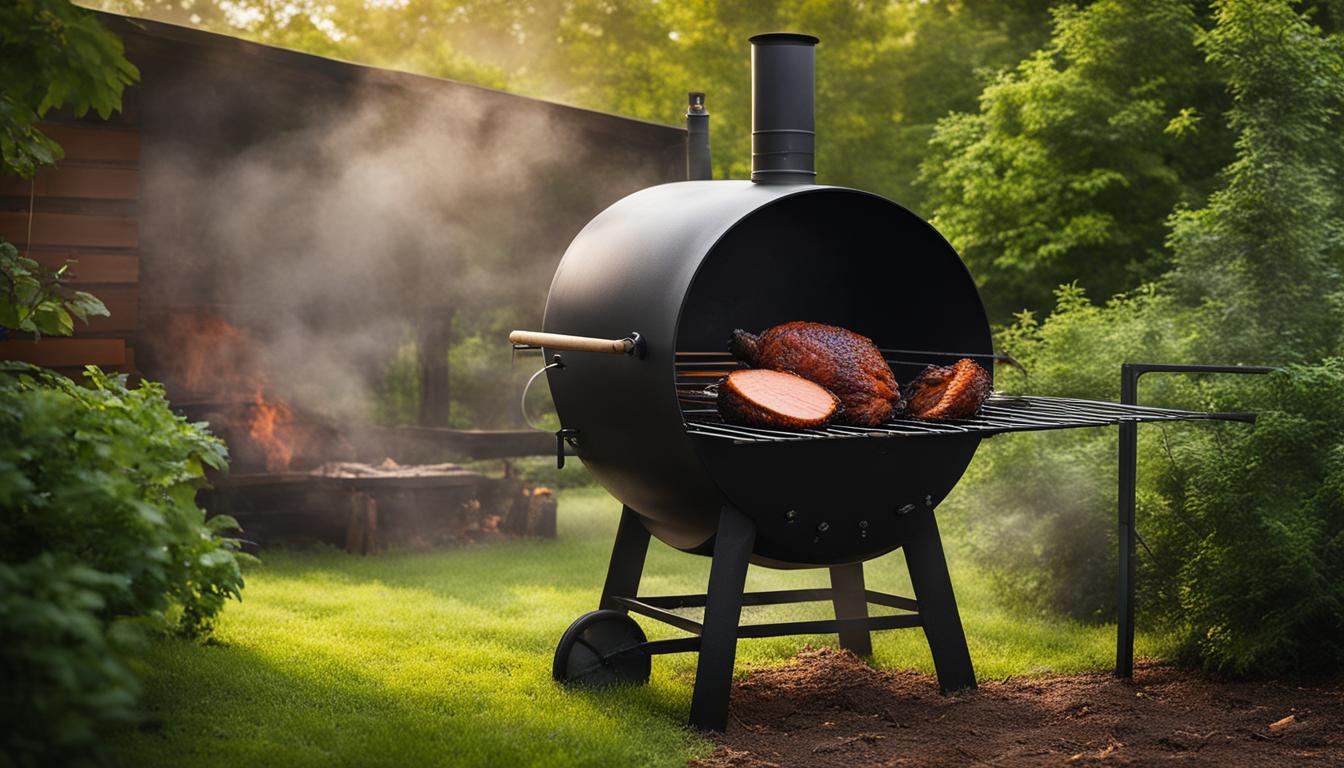When it comes to perfecting the art of smoking pork butt, a heated debate often arises: Should you smoke pork butt fat side up or down? As a seasoned pitmaster, I’ve explored various pork butt smoking techniques, adhering to the belief that the best way to smoke pork butt is with the fat cap up.
This methodology isn’t just based on tradition but on solid experience and the influences of barbecue experts like Michael Haas and Aaron Franklin, who use the fat cap’s behavior as a crucial indicator during the long, slow smoking process.
There’s more to this preference than mere choice—a layer of reasoning, from the type of smoker at play to the physics of rendering fat. Pellet grills and offset smokers, with their convection heating patterns, make a compelling case for a fat side up approach, leveraging the protective and self-basting qualities of the pork’s own fat cap. It’s a style that fosters juicy tenderness and allows for the kind of visual monitoring crucial to a successful smoke.
Join me as I delve into the reasons behind my preference for smoking pork butt fat side up, offering insights into generating that perfect blend of savory bark and supple, aromatic meat.
Key Takeaways
- Fat cap up is the preferred recommendation for smokers where heat comes from above, such as pellet grills and offset smokers.
- Balancing fat rendering with seasoning retention is essential when smoking pork butt with the fat side up.
- Visual indicators, like the fat cap splitting, provide valuable cues for determining smoking progress and readiness for wrapping.
- A comprehensive approach manages both the art and science of smoking, from fat cap considerations to smoker mechanics.
- Pitmaster legends such as Franklin and Haas have influenced the favored method, contributing to its popularity and adoption.
- Understanding the smoker’s design and heating source is crucial in deciding whether to smoke pork butt fat side up or down.
- Consistency in temperature and smoke exposure is vital for achieving the desired results in texture and flavor.
Introduction to Smoking Pork Butt
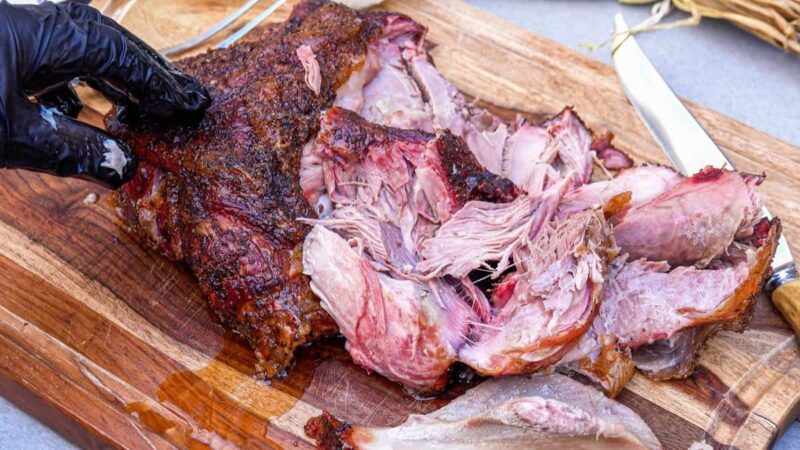
When embarking on the journey of smoking a pork butt, I’m often asked by fellow barbecue enthusiasts for smoking meat tips that can lead to that perfect balance between a crispy bark and a succulent, moist interior. Any pitmaster knows that maintaining moisture in smoked pork butt is paramount to achieving a quality end product.
The meat itself, given its rich marbling and substantial fat layer, provides a natural reservoir for tenderness and flavor. The key deliberation comes down to a simple, yet critical question: should you position your pork butt fat side up or fat side down on the smoker?
This is not just a trivial choice, as the fat cap—this hard, white layer of fat that sits atop the Boston butt—plays a significant role in the smoking process. Opting for the fat side up advocates swear by its self-basting ability, claiming it shields the meat from potentially drying out, thus maintaining that quintessential juiciness pork aficionados crave. In contrast, the fat side down method proposes that the fat cap acts as an insulator against direct heat, potentially enhancing the bark’s texture, thereby preserving the richness imbued by the seasoning.
As someone who prides themselves on their smoked meats, my approach considers several factors: the type of smoker, the distribution of heat within it, and the desired outcome in terms of taste and textural contrast. By merging personal experience with tried and true methods, I find the path to the ideal pork butt lies within understanding these elements in their entirety.
| Orientation | Juiciness | Bark Quality | Protection Against Heat | Seasoning Retention |
|---|---|---|---|---|
| Fat Side Up | Surface basting | Can be excellent if wrapped at right time | Less direct, fat acts as a shield | Potential wash-off of seasoning on surface |
| Fat Side Down | Preserved inward juiciness | Thicker and more robust due to heat exposure | Direct, with fat protecting the meat | Higher seasoning adherence |
Equipped with this understanding, my technique involves a strategy formulated through a blend of preference and practicality. When it comes to maintaining moisture in smoked pork butt, I find that positioning the pork butt fat side up serves to my—and the meat’s—advantage the majority of the time.
Yet I stay adaptable, aware that each smoker has its quirks and demands, and stand ready to adjust when the pursuit of smoked pork perfection calls for it.
- Analyzing smoker design to determine optimal fat cap orientation.
- Ensuring that seasoning penetrates effectively while balancing fat rendering.
- Considering the texture and flavor outcome desired, and aligning cooking methods accordingly.
“Every great pitmaster understands that the secret to unforgettable pork butt is found in the nuances of the smoking process—the interplay between meat, heat, and fat is where true barbecue mastery is honed.”
- Begin by selecting a quality pork butt with a well-defined fat cap.
- Trim the fat cap to an appropriate thickness, balancing self-basting and heat insulation properties.
- Season liberally, using rubs that complement rather than overpower the natural flavors of the pork.
- Monitor heat and smoke levels closely, understanding how they interact with the fat cap’s position.
- Remaining observant and adaptable, ready to adjust technique to achieve the pinnacle of pork butt excellence.
The Great Debate: Fat Cap Orientation in Smoking
When I ignite my smoker and the scent of hardwood fills the air, my focus shifts to the prime cut of meat before me—the pork butt with its distinctive fat cap. The decision of whether to smoke the pork butt fat side up or fat side down ignites a debate within the barbecue community hotter than the coals in my smoker.
Some contend that smoking pork butt fat side up is the key to moisture maintenance and flavor, while others argue that fat cap orientation should be dictated by the heat source’s direction to shield and protect the meat.
As I’ve honed my craft over years of low and slow smoking sessions, I’ve observed the merits in both arguments. The fat cap on pork butt isn’t merely a thick layer to be dismissed—it’s a crucial factor in crafting a successful smoke. Its role, from acting as a barrier to direct heat, to melting over the meat’s surface as a self-baster, cannot be overstated.
The question has less to do with right and wrong and more to do with making informed choices based on the specific circumstance of each smoke session. This includes careful consideration of smoker design, the physical properties of pork fat, and the desire to lock seasoning into the forming bark.
Knowing your equipment and understanding the process are everything in barbecue, and that includes the fat cap’s role in smoking pork butt. The decisions made here can enhance or hinder the transformation from a raw piece of meat to a delectably smoked delight.
| Aspect | Fat Side Up | Fat Side Down |
|---|---|---|
| Heat Source Protection | Limited; potential for more direct exposure | Acts as an insulating layer |
| Moisture on Meat Surface | Enhanced through self-basting | Reduced; fat does not cover the surface |
| Seasoning Retention | At risk from rendered fat wash-off | Better preserved against direct heat |
| Visual Cooking Cues | Observable fat cap changes | Less immediate visual feedback |
In my own experience, I’ve leaned towards smoking pork butt fat side up because it suits my style and the type of smoker I use. Seeing the fat cap slowly render, bubble, and split is not just satisfying—it’s informative.
It tells me when the pork butt is ready for the next phase of cooking, whether that’s wrapping to lock in moisture or adjusting the heat. Truthfully, the decision is nuanced and reflective of the pitmaster’s intention and smoker at hand.
- I consider the type of smoker being used and the direction of the heat source before deciding.
- I am mindful of the fat cap’s thickness for effective rendering which influences moisture maintenance.
- Observing the gradual splitting of the fat cap provides a natural cue for wrapping without relying solely on time or internal temperature.
Whether choosing to smoke fat side up or down, it’s an integral part of the craft to understand that each choice you make adds a layer to the flavor profile and texture of the finished product. By recognizing the role of the fat cap on pork butt during smoking, we master an element of barbecue artistry that elevates the smoking process from simply cooking to culinary storytelling.
Understanding the Fat Cap on Pork Butt
As an enthusiast of barbecue and smoked meats, I’ve explored every angle and nuance of perfecting pork butt, focusing especially on the intricacies of the fat cap. Knowing how to handle the fat cap can be the differentiator between a good smoked pork butt and a phenomenal one, rich in flavor and irresistibly tender. It’s the thick layer that requires attention before the pork butt even sees the smoker.
Defining the Fat Cap
The fat cap is the substantial and undeniable layer of hard fat that sits proudly on one side of the pork butt, setting it apart from leaner surfaces. Throughout my smoking ventures, I’ve identified this layer as more than just excess—it’s key for achieving the succulent texture and profound taste associated with immaculately smoked pork.
Marbled within this fat cap is intramuscular fat, the kind that renders down during the long, low heat of smoking to transform the meat into that fork-tender, fall-apart delicacy.
Trimming the Fat Cap for Optimal Smoking
When it comes to **pork butt fat cap rendering**, the smoking process demands precision. Trimming the fat cap to the recommended 1/4 inch thickness is a ritual I’ve refined, striking a balance between enough fat to self-baste the pork butt and preventing an overwhelming layer that refuses to render.
Poorly trimmed fat caps do not fare well in the smoker; they emerge less rendered than desired, leaving a layer that’s anything but appetizing. This attention to detail ensures that as the **fat cap on pork butt** slowly yields to the heat, it blankets the meat in a moistening coat, contributing a delicate texture without becoming cumbersome to the diner.
“Masterful smoking begins long before the meat hits the heat—it starts with the precision trimming of the fat cap, a vital step towards a smoked pork butt that’s equally as tender on its exterior as it is within.”
- Trimming should leave approximately 1/4 inch of the fat cap—no more, no less.
- Evenly trimmed fat ensures uniform rendering and basting.
- Appropriate trimming optimizes the smoking process for a delectable crust.
| Process | Goal | Result |
|---|---|---|
| Trimming the Fat Cap | To enable effective rendering and self-basting | A more tender, juicy pork with a flavorful crust |
| Rendering During Smoking | To liquefy intramuscular fats for taste and texture | Sumptuous, fall-apart tenderness characteristic of expertly smoked pork |
| Final Product | To achieve the perfect balance of rendered fat and seasoned bark | A porcine masterpiece with every bite offering layers of complexity and savoriness |
In my arsenal of smoking techniques, understanding and applying the principles of trimming and rendering the fat cap is equivalent to arming oneself with the skillful touch necessary for outstanding barbecue.
Every decision and cut wields influence upon the smoking process, subsequently upon the gathering of friends and family who eagerly await the ritual of pulled pork perfection.
Benefits of Smoking Pork Butt with Fat Side Up
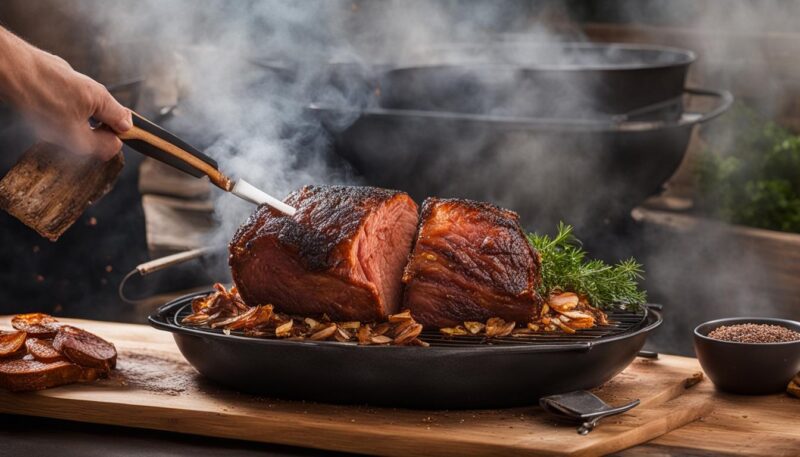
Throughout my journey as a pitmaster, I’ve continually sought to refine my pork butt smoking techniques. Embracing the art of self-basting smoking has profoundly impacted the moisture maintenance in smoked pork butt.
Notably, when the fat cap renders, its juices cascade over the meat’s surface, engendering an environment where dryness is discouraged and a moistness prevails.
But the benefits are not purely hydration-centric. The process, akin to the self-basting technique where the melting fat acts as an organic baste for the pork butt, also contributes substantially to the meat’s exterior succulence. The true testament to this approach comes not just in moisture, but in texture and flavor—aspects deeply revered in barbecue culture.
Moisture Maintenance through Self-Basting
Dive into the understanding of how the self-basting method is much more than just a protective layer—it’s a component of culinary precision. The natural basting effect, which plays out as the fat cap reduces to liquid form, is one of the key reasons why I staunchly advocate for the fat side up technique. It is a ritual that not only fortifies the meat’s moisture but also provides aesthetically pleasing and practically relevant visual cues to its readiness.
As a significant indicator, the splitting of the fat cap is not merely mechanical separation—it’s a milestone. It suggests that the pork butt has reached a stage where it is primed for the next step, be it wrapping or adjusting the temperature for the continuation of the smoke.
| Smoking Technique | Impact on Moisture | Impact on Flavor |
|---|---|---|
| Self-Basting (Fat Side Up) | Prevents surface drying, enhances exterior moistness | Flavorful juices from rendered fat aid taste development |
| Non Self-Basting (Fat Side Down) | Potential for drier surface due to lack of fat coverage | Seasoning remains intact, offering a different flavor profile |
My personal credo is rooted in this strategy because time and again, it has validated itself through every smoke-laden bite. The commitment to smoking pork butt fat side up is a testament to both tradition and innovation, as I meld ancestral practices with contemporary smoking insights.
Potential Drawbacks of Smoking Meat Fat Side Up
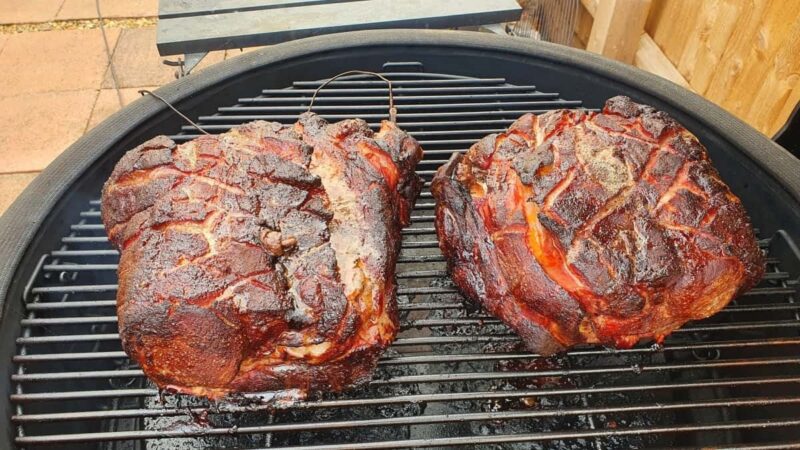
As an enthusiast of the smoking meat tradition, I am frequently asked about the best practices to ensure that juicy, fall-apart pork butt that becomes the centerpiece of any meal.
A common topic in smoking meat FAQs is whether to position the fat side up or down during smoking. While many pitmasters, myself included, often prefer smoking fat side up for various reasons, there are potential drawbacks to this method that need consideration for a successful barbecue.
One notable challenge when smoking meat fat side up is the risk of the rendered fat washing away the carefully applied dry seasoning rub. The rub is essential for building a robust bark and imparting deep flavors throughout the meat.
When the fat cap is positioned upward, the melting fat can create rivulets as it drips, potentially causing some of the seasoning to slide off before it has a chance to form a crust, thus potentially compromising the flavors we worked so hard to develop.
Moreover, maintaining moisture in smoked pork butt is high on my priority list, but this can become problematic if intense direct heat accesses the meat’s surface. This can occur if my smoker’s heat source is predominantly from beneath.
The meat, no longer shielded by the fat cap, might experience surface drying or, in severe cases, even a touch of overcooking on the exposed meat surfaces. To counter this, one must apply a liberal amount of seasoning to the meat and consider the smoker’s behavior during the cooking process.
While smoking pork butt with the fat side up can produce exceptional results, we must acknowledge and remedy these limitations to ensure peak flavor and moisture are achieved.
Adaptations may be necessary, such as wrapping the pork butt during the smoke to protect the seasoning and trap moisture, or adjusting the smoker’s heat source if possible. Taking extra care to monitor the temperature and moisture levels becomes even more critical to maintain the sumptuous qualities of the smoked meat.
| Challenge | Impact on Smoking Process | Strategies for Mitigation |
|---|---|---|
| Fat Washing Away Seasoning | Loss of flavor depth from seasoning rub | Apply seasoning liberally, wrap meat to protect crust formation |
| Direct Heat Intensity | Potential for surface drying or overcooking | Monitor and adjust heat source, wrap to retain moisture |
In light of these considerations, when I smoke pork butt with the fat side up, it’s done with an awareness of the challenges. Managing these risks effectively is what turns a good smoked pork butt into an unforgettable culinary masterpiece.
- Always be vigilant of seasoning adherence when using the fat side up method.
- Guard against the effects of direct heat by considering smoker heat dynamics and wrapping techniques.
- Maintain strict temperature control to ensure consistent smoking conditions.
Reasons to Consider Smoking Pork Butt Fat Side Down
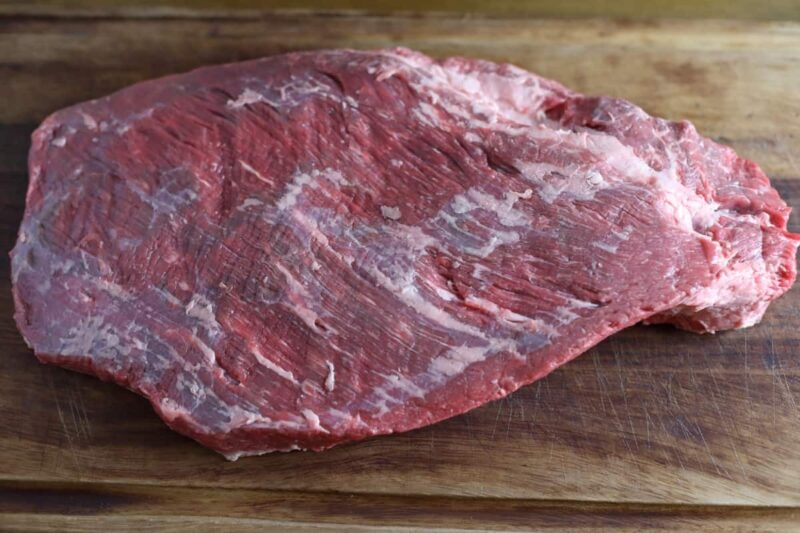
As a pitmaster deeply immersed in the art and science of smoking meats, I’ve invested considerable time understanding how fat cap orientation affects the smoking process.
Smoking pork butt fat side down has notable benefits that warrant serious consideration. One of the essential smoking meat tips that has circulated among enthusiasts is the acknowledgment of heat source placement and its effect on the meat.
When the heat radiates from beneath, like with barrel and vertical smokers, positioning the pork butt fat side down serves as prime strategy. The fat cap becomes a shield, insulating the meat from the severe intensity of the heat, resulting in a protective layer that not only safeguards against overcooking but also allows for a more consistent cook.
Using the fat as a barrier is a technique steeped in practicality. It allows for direct heat to render the fat without causing the delicate meat beneath to suffer from excessive exposure.
The additional bonus of this approach is bark development. By allowing the fat to face the heat directly, the surface that is seasoned becomes well-exposed to the smoke, preserving the rub’s rich flavors that build a robust bark—a prized element in smoked meats.
| Aspect of Smoking | Impact When Fat Side Down |
|---|---|
| Protection Against Direct Heat | Serves as an insulating layer, reducing risk of overcooking |
| Bark Formation | Enhanced flavor retention from seasonings, leading to a more robust bark |
| Fat Rendering | Fat drips away from the meat, potentially reducing flare-ups |
| Visual Appearance | Leads to an even, well-developed crust on the meat’s surface |
Understanding the mechanics of your smoker is pivotal in making an informed decision on whether to smoke pork butt fat side down. It’s a testimony to the complexity and nuance of smoking meat, where even the heat source’s direction can influence the outcome profoundly.
- Maintaining low and steady temperatures is critical, guaranteeing uniform cooking.
- The natural juices and rendered fat should coat the pork butt gently, preventing surface dehydration.
- A meticulously applied seasoning rub is crucial—smoking meat fat side down accentuates these flavors.
Every choice in the smoking process—from preparation to plate—holds weight. Embracing the method of smoking pork butt fat side down reveals my commitment to texture and flavor that resonates with traditional barbecue technique while responding insightfully to the physics of heat and smoke.
Risks Associated with Smoking Pork Butt Fat Side Down
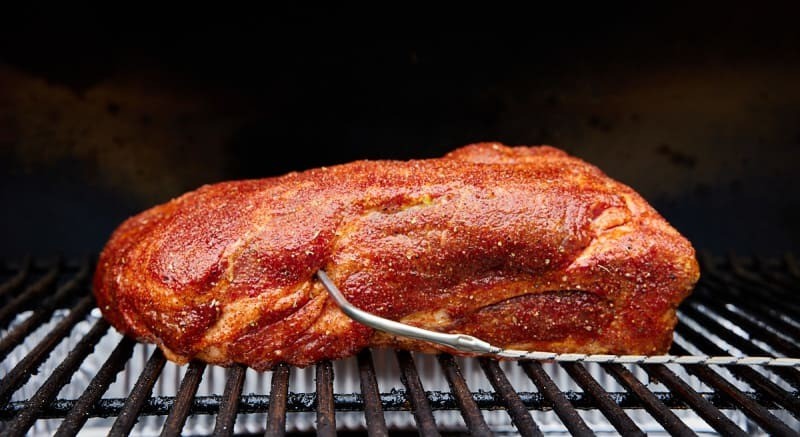
As a dedicated pitmaster, I’m always keen on refining the smoking process to achieve that perfectly smoked pork butt. Smoking meat with the fat side down does indeed offer protective benefits, creating a barrier between the meat and the heat source.
However, this approach is not without its potential risks. The foremost challenge lies with the dreaded flare-ups in smoking meat, as well as the additional duty of grill maintenance for smoking.
Flare-Ups and Grill Maintenance
When the pork butt is placed fat side down, the fat drippings can interact more directly with the heat source. Whether you’re smoking on a classic Weber Smokey Mountain, or utilizing cutting-edge pellet grills, this interaction can lead to sudden and intense flare-ups. These flare-ups are not only a safety concern, but they can also result in uneven cooking and potentially charred portions of that succulent pork butt.
Moreover, meticulous grill maintenance for smoking becomes even more critical in this configuration. Rendered fat can be sticky and stubborn, adhering to the grill grates with grim persistence. Post-smoke cleanup can morph into a tiresome chore, detracting from the otherwise joyous experience of serving up mouth-watering barbecue.
“Mastering the grill means mastering the flames. Controlling flare-ups in smoking meat is as essential as the spices in your rub—it’s all about balance and technique.”
Let’s not forget the pork butt itself. If not carefully and strategically removed, the pork can easily stick to the grates, resulting in the meat tearing—compromising its presentation and possibly wasting those flavorful, smoked edges we all covet. For those who prioritize minimal maintenance, smoking pork butt fat side up might be the more attractive route.
| Smoking Position | Risk | Preventive Action |
|---|---|---|
| Fat Side Down | Grill Flare-Ups | Use a drip pan, maintain lower cooking temperatures |
| Fat Side Down | Sticking to Grates | Regular grill cleaning, oil grates before smoking |
| Fat Side Down | Uneven Cooking | Monitor frequently, rotate meat if necessary |
In conclusion, while smoking pork butt fat side down might be the conventional wisdom for certain smoker types, it’s crucial to remain vigilant about flare-ups and grill maintenance. Adopting preemptive measures can alleviate risks and ensure a smooth smoking experience. Your vigilance will reward you with a pork butt that’s delectable, aromatic, and simply unforgettable.
- Consider the pros and cons of fat side orientation when preparing to smoke.
- Stay attentive to flare-ups for safety and optimal cooking results.
- Regular grill maintenance for smoking is imperative for both the smoke session and longevity of your equipment.
My Go-To Method for Smoking Pork Butt
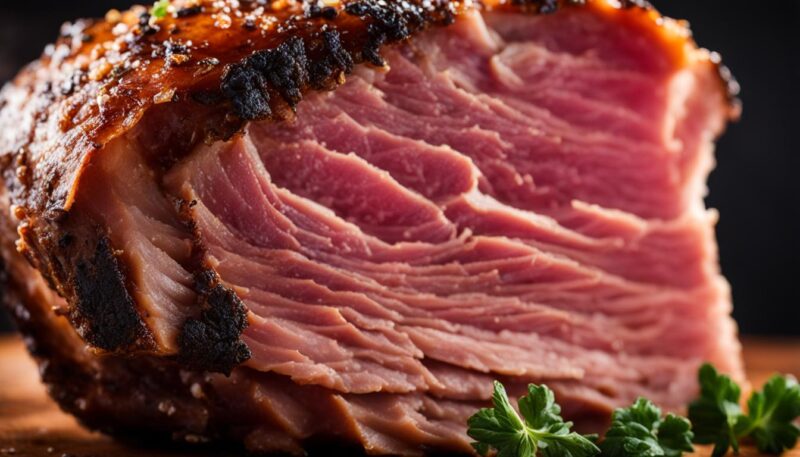
When I embark on the ritual of smoking pork butt, the foundation of my pork butt smoking techniques starts with a simple but crucial decision—fat side up. Time and seasoning have solidified this method as the best way to smoke pork butt in my repertoire, especially in smokers where heat envelops the meat rather than attacking it from below, like in pellet grills and offset smokers.
Self-basting is a term that gets thrown around in barbecue circles, but it’s not just jargon—it’s essential for maintaining a moist and tender pork butt. As the fat cap slowly renders, it naturally bastes the meat, ensuring that every inch is imbued with rich, succulent flavors.
Moreover, being able to visually inspect the splitting of the fat cap proves invaluable. It acts as a natural cue, alerting me to the pork’s readiness for wrapping, signaling the appropriate time to envelop the butt in its foil cocoon to push through the stall—a technique I endorse to preserve that precious moisture and develop an almost buttery texture.
Monitoring the internal temperature is paramount, and I advocate for the use of a reliable thermometer to ensure accuracy without frequently opening the smoker—each peek inside is an opportunity for heat and smoke to escape, the nemeses of consistent smoking. And while my method leans heavily on the fat side up technique, flexibility remains a key ingredient in the alchemy of barbecue.
“Striking the right balance between flavor, moisture, and that enviable bark is a dance, and the fat cap leads every step of the way.”
| Technique Aspect | Reasoning | Benefits |
|---|---|---|
| Fat Side Orientation | Maximizes self-basting, preserves moisture, and provides visual cues | Enhanced juiciness and flavor density |
| Internal Temperature Monitoring | Ensures proper cooking without loss of heat and smoke | Optimal tenderness and avoidance of over/undercooking |
| Convection Heat Advantage | Utilizes smoker design for even cooking and efficient fat rendering | Uniform succulence and a more consistent bark across the pork butt |
Not one to be chained to tradition without reason, I remain open to adjustments, keenly observing how different smokers and conditions may influence the process. Yet, through it all, the fat side up approach stands tall as the backbone of my pork butt smoking exploits.
- Prioritize an even trim on the fat cap to facilitate efficient rendering.
- Utilize visual clues like the split in the fat cap to make timely decisions.
- Wrap the pork butt judiciously, only when it’s beneficial for the meat’s texture and moisture content.
In essence, smoking pork butt is an art form shaped by preference, practicality, and patience. Fat side up is not just a mantra, it’s my proven method for delivering irresistibly smoked pork butt time and time again.
Expert Tips for Mastering the Smoking Process
As I continue to elevate my craft in smoking meats, I lean on a bevy of expert smoking techniques, each honed to perfection with countless hours beside the smoker. For those yearning to understand the secrets of smoking meat tips and to wow guests with delectable, fall-off-the-bone pork butt, it begins with understanding the intricate dance of smoke, heat, and meat.
Navigating the smoker’s heat is fundamental. A steady and consistent heat ensures the meat undergoes the transformation that only low-and-slow cooking can achieve. To ensure this, I swear by the efficiency of **digital wireless thermometers**.
These allow me to monitor the meat’s temperature meticulously, without the disruptive act of opening the smoker, which can lead to unwelcome loss of heat and smoke—two elements as precious as the meat itself.
“A wireless thermometer is not just a tool; it’s your silent partner in the quest for smoking perfection. It watches over your meat, giving you peace of mind and the freedom to step away from the smoker without fear of overcooking.”
Another aspect that cannot be overstated is that the meat needs to remain largely undisturbed. The theater of smoke and warmth creates a cocoon, within which flavors intensify and mature. Opening the smoker too often disrupts this process, much like waking a masterpiece from its slumber too soon.
Learning the unique quirks of your smoker, whether it be a classic offset smoker or a modern pellet grill, is vital. The type and direction of heat source are guiding factors when deciding whether to smoke a pork butt with the fat cap up or down.
These pieces of knowledge converge gracefully when it’s time to trim the pork butt—meticulously executed to bestow an optimal thickness that renders beautifully without overwhelming the meat.
Here’s a table that illustrates the proper orientation of the pork butt based on the type of smoker used:
| Smoker Type | Heat Source | Recommended Pork Butt Orientation |
|---|---|---|
| Offset Smoker | Side Fire Box | Fat Side Up |
| Pellet Grill | Underneath/Auto-feed | Fat Side Up or Down, depending on model |
| Vertical/Water Smoker | Underneath/Coal | Fat Side Down |
| Kettle Grill | Bottom/Briquettes | Fat Side Down |
Let me share further, an ordered list of key points, that draw the fine line between a good smoke and a great smoke:
- Start with a quality pork butt, ensuring a well-defined fat cap for optimal flavor and moisture.
- Trim the fat cap to about a quarter-inch to facilitate proper rendering and prevent it from overwhelming the meat.
- Season assertively, allowing your spice blend to form a tantalizing crust, full of character.
- Understand that heat management is a pillar of smoking—keep temperatures consistent and disruptions to a minimum.
- Utilize tools such as a wireless thermometer to guard against heat loss and to monitor internal temperatures reliably.
- Exercise patience. Great barbecue is more marathon than sprint, embracing the slow transmutation of raw protein into smoked treasure.
So, whether you are a seasoned smoker or aspiring to join the ranks of pitmasters, embrace these smoking meat tips and expert smoking techniques to transform your pork butt into a culinary work of art.
Conclusion: Mastering the Art of Smoking Pork Butt
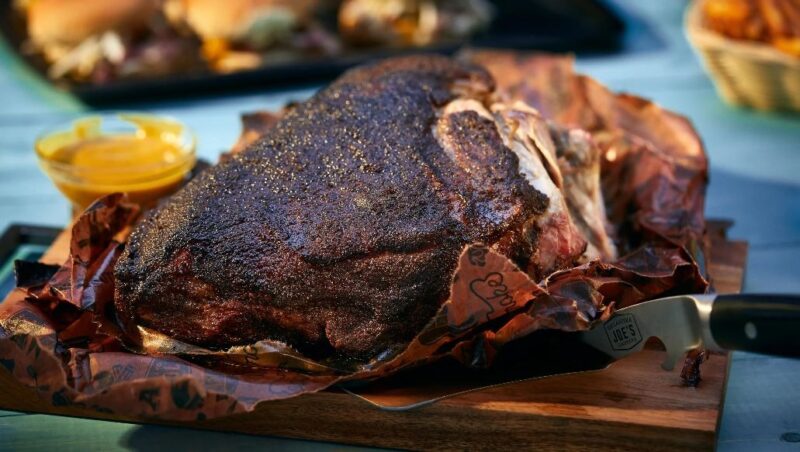
In summarizing the journey through the thick smoke of barbecue debate, a recurring theme emerges in the smoking meat FAQs: deciding fat side up or down is more than a matter of personal preference.
Instead, it represents a deliberate choice by each pitmaster tailored to optimize the result based on smoker type and desired outcome. The best way to smoke pork butt intertwines a keen understanding of the cut’s characteristics with the smoker’s heat distribution, allowing flavors and textures to harmoniously converge into a tender masterpiece.
While some advocate for the self-basting method of fat side up to maintain moisture and safeguard the meat, others point to the protective benefits of smoking fat side down against direct heat sources.
In my own extensive experience with the aromas and whisps of pecan and hickory, I’ve come to embrace smoking pork butt fat side up on my trusted pellet grill, recognizing the advantage it offers in terms of consistent cooking and visual indicators for wrapping.
No matter which side of the debate you land on, it is clear that smoking pork butt is an art form balanced on a fat cap, where the dance between meat, heat, and smoker is nuanced and complex.
A steadfast attention to detail, temperature control, and technique is what separates a good smoked pork butt from a great one. Whether smoking your pork butt fat side up or down, may your patience and dedication lead you to the most succulent and flavorful barbecued pork at your table.
FAQ
Should You Smoke Pork Butt Fat Side Up or Down?
The decision to smoke pork butt fat side up or down largely depends on the type of smoker being used. For pellet grills and offset smokers, smoking fat side up is often preferred to allow self-basting and for monitoring cooking progress.
For vertical or barrel smokers, where the heat source is directly below, fat side down may provide protection from direct heat and potentially result in a better bark. Personal preference regarding the end result in terms of tenderness and flavor also plays a role.
What Are the Benefits of Smoking Pork Butt with the Fat Side Up?
Smoking pork butt with the fat side up can aid in moisture maintenance through self-basting as the fat cap renders and trickles down over the meat, which can help keep the surface moist and contribute to a juicier final product. It also allows visual indicators, such as the splitting of the fat cap, that signify when the meat is ready to be wrapped.
Are There Any Drawbacks to Smoking Meat Fat Side Up?
One potential drawback of smoking meat with the fat side up is the rendered fat washing away some of the dry seasoning rub, which could result in a loss of desired flavor. If the smoker’s heat source is mainly coming from beneath, the meat surface might be exposed to too much direct heat, which could lead to overly tough bark or char.
Why Would You Consider Smoking Pork Butt Fat Side Down?
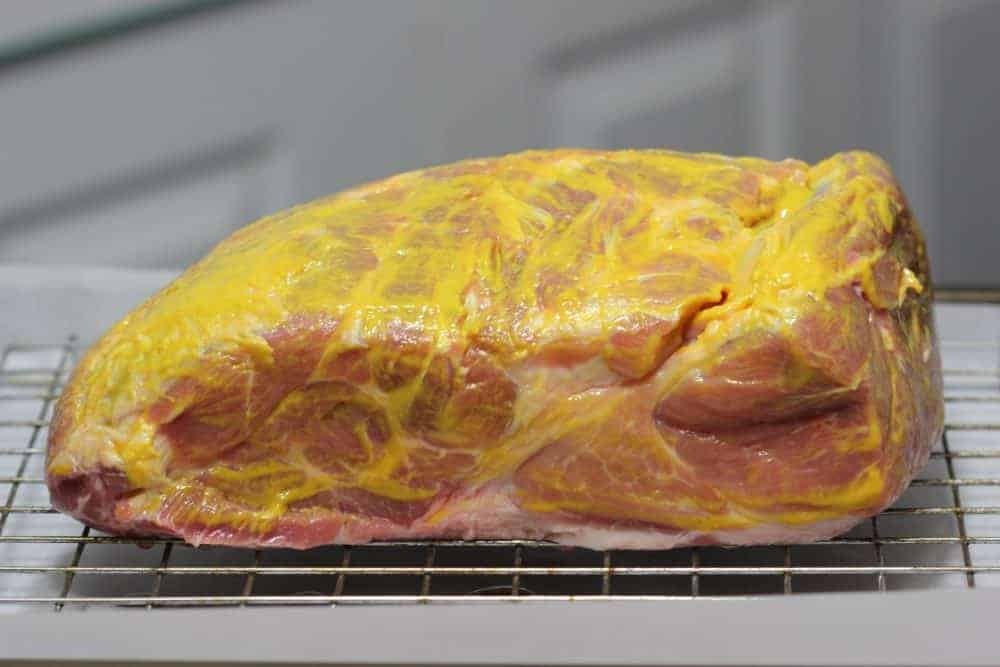
Smoking pork butt fat side down is considered mainly when using smokers where the heat source is from below, such as vertical or barrel smokers. The fat cap serves as an insulation layer to protect the meat from direct heat, minimizing the chance of overcooking the surface closest to the heat source. This technique can also result in a more flavorful and well-formed bark on the meat surface.
What Are the Risks of Smoking Pork Butt with the Fat Side Down?
When smoking pork butt fat side down, you might face risks like flare-ups due to fat drippings hitting the heat source, which can cause inconsistent temperatures. Additionally, the rendered fat may stick to the grill grates, making cleanup difficult and possibly harming the pork butt when it’s time to remove it from the grill.
How Do You Prefer to Smoke Your Pork Butt?
I prefer smoking pork butt with the fat side up, particularly in smokers like pellet grills or offset smokers where the heat comes from the side or circulates around. This method supports the self-basting process and allows for easier monitoring of the meat’s cooking progress, ensuring a tender and flavorful end product.
What Are Some Expert Tips for Mastering the Smoking Process?
To master the smoking process, consistently managing the heat to maintain stable temperatures is critical. It is recommended to use a digital wireless meat thermometer to monitor internal temperatures without frequently opening the smoker.
Additionally, minimize flipping or moving the meat to ensure it absorbs the smoke evenly. Proper trimming of the fat cap to about ¼ inch thickness will help with optimal rendering, enhancing both the flavor and texture of the smoked pork butt.

